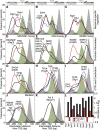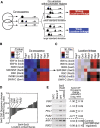A canonical promoter organization of the transcription machinery and its regulators in the Saccharomyces genome
- PMID: 19124666
- PMCID: PMC2661807
- DOI: 10.1101/gr.084970.108
A canonical promoter organization of the transcription machinery and its regulators in the Saccharomyces genome
Abstract
The predominant organizational theme by which the transcription machinery and chromatin regulators are positioned within promoter regions or throughout genes in a genome is largely unknown. We mapped the genomic location of diverse representative components of the gene regulatory machinery in Saccharomyces cerevisiae to an experimental resolution of <40 bp. Sequence-specific gene regulators, chromatin regulators, mediator, and RNA polymerase (Pol) II were found primarily near the downstream border from the "-1" nucleosome, which abuts against the approximately 140-bp nucleosome-free promoter region (NFR). General transcription factors TFIIA, -B, -D, -E, -F, -H were located near the downstream edge from the NFR. The -1 nucleosome dissociated upon Pol II recruitment, but not upon recruitment of only TBP and TFIIB. The position of many sequence-specific regulators in promoter regions correlated with the position of specific remodeling complexes, potentially reflecting functional interactions. Taken together the findings suggest that the combined action of activators and chromatin remodeling complexes remove the -1 nucleosome after the preinitiation complex (PIC) has partially assembled, but before or concomitant with Pol II recruitment. We find PIC assembly, which includes Pol II recruitment, to be a significant rate-limiting step during transcription, but that additional gene-specific rate-limiting steps associated with Pol II occur after recruitment.
Figures







Similar articles
-
A high-resolution protein architecture of the budding yeast genome.Nature. 2021 Apr;592(7853):309-314. doi: 10.1038/s41586-021-03314-8. Epub 2021 Mar 10. Nature. 2021. PMID: 33692541 Free PMC article.
-
Mediator, TATA-binding protein, and RNA polymerase II contribute to low histone occupancy at active gene promoters in yeast.J Biol Chem. 2014 May 23;289(21):14981-95. doi: 10.1074/jbc.M113.529354. Epub 2014 Apr 11. J Biol Chem. 2014. PMID: 24727477 Free PMC article.
-
Recruitment of TBP or TFIIB to a promoter proximal position leads to stimulation of RNA polymerase II transcription without activator proteins both in vivo and in vitro.Biochem Biophys Res Commun. 1999 Mar 5;256(1):45-51. doi: 10.1006/bbrc.1999.0280. Biochem Biophys Res Commun. 1999. PMID: 10066420
-
Multi-protein complexes in eukaryotic gene transcription.Plant Mol Biol. 2002 Dec;50(6):925-47. doi: 10.1023/a:1021258713850. Plant Mol Biol. 2002. PMID: 12516863 Review.
-
Role of the TATA-box binding protein (TBP) and associated family members in transcription regulation.Gene. 2022 Jul 30;833:146581. doi: 10.1016/j.gene.2022.146581. Epub 2022 May 18. Gene. 2022. PMID: 35597524 Review.
Cited by
-
Extensive transcriptional heterogeneity revealed by isoform profiling.Nature. 2013 May 2;497(7447):127-31. doi: 10.1038/nature12121. Epub 2013 Apr 24. Nature. 2013. PMID: 23615609 Free PMC article.
-
Constitutive turnover of histone H2A.Z at yeast promoters requires the preinitiation complex.Elife. 2016 Jul 20;5:e14243. doi: 10.7554/eLife.14243. Elife. 2016. PMID: 27438412 Free PMC article.
-
Insights into distinct regulatory modes of nucleosome positioning.BMC Genomics. 2009 Dec 14;10:602. doi: 10.1186/1471-2164-10-602. BMC Genomics. 2009. PMID: 20003404 Free PMC article.
-
The RSC chromatin remodelling enzyme has a unique role in directing the accurate positioning of nucleosomes.EMBO J. 2011 Apr 6;30(7):1277-88. doi: 10.1038/emboj.2011.43. Epub 2011 Feb 22. EMBO J. 2011. PMID: 21343911 Free PMC article.
-
Transcription mediated insulation and interference direct gene cluster expression switches.Elife. 2014 Nov 19;3:e03635. doi: 10.7554/eLife.03635. Elife. 2014. PMID: 25407679 Free PMC article.
References
-
- Albert I., Mavrich T.N., Tomsho L.P., Qi J., Zanton S.J., Schuster S.C., Pugh B.F. Translational and rotational settings of H2A.Z nucleosomes across the Saccharomyces cerevisiae genome. Nature. 2007;446:572–576. - PubMed
-
- Angermayr M., Bandlow W. Permanent nucleosome exclusion from the Gal4p-inducible yeast GCY1 promoter. J. Biol. Chem. 2003;278:11026–11031. - PubMed
-
- Arigo J.T., Eyler D.E., Carroll K.L., Corden J.L. Termination of cryptic unstable transcripts is directed by yeast RNA-binding proteins Nrd1 and Nab3. Mol. Cell. 2006;23:841–851. - PubMed
-
- Basehoar A.D., Zanton S.J., Pugh B.F. Identification and distinct regulation of yeast TATA box-containing genes. Cell. 2004;116:699–709. - PubMed
-
- Berger S.L. Gene regulation. Local or global? Nature. 2000;408:412–413, 415. - PubMed
Publication types
MeSH terms
Substances
Grants and funding
LinkOut - more resources
Full Text Sources
Other Literature Sources
Molecular Biology Databases
